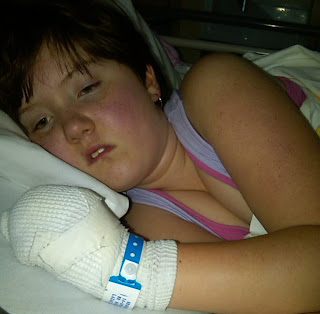We arrived at the Children's Hospital ER after midnight sometime. Doctors still had not determined what was wrong and even LET US GO HOME FOR THE NIGHT???!!! The neurologist was due to come in the next morning (Sunday) and the doctors felt Stephanie may be more relaxed and at ease in her own bed because of her autism. So we headed home, she was essentially blind at this point and I had to walk her up 3 flights of stairs to our apartment. A few hours later, when we woke up, we headed back to the ER.
The following two pictures are of that first morning. The neurologist saw Stephanie and suspected she was in status epilepticus. EEG results showed mostly normal results and a Dilantin load proved that she was not having a seizure...her symptoms continued. She was admitted into hospital that day.
It was not until July 13th, 3 days later in hospital, that anyone actually looked into the back of her eyes. She finally saw the opthamologist and I will never forget his reaction to what he saw when he looked into her eyes. He literally said, "Oh my god there's major hemorrhaging". To be honest with you, up until that point the opthamologist was being more than a bit impatient and short with us because Stephanie wouldn't get into the examining chair. Once he took a look at her, his disposition immediately changed and he was even apologetic.
I was so scared of what this meant for her and sobbed uncontrollably as I gave my husband the news. She had major hemorrhaging of her optic discs, caused by increased fluid pressure on her brain.
She immediately had a procedure called a lumbar puncture. As I write this story almost 2 years later, she is about to have her 19th lumbar puncture. Maybe the neurologist will allow for me to take pictures or video of this? Hmm, I'll have to remember to ask. Anyway, back to her first one...the purpose of the lumbar puncture was to determine the pressure reading of the cerebral spinal fluid (csf) and to take samples for further testing. Well, as a great shock to the neurologist and the staff in the room (I have been allowed into each one of her lumbar puncture procedures) Stephanie's opening pressure was so incredibly high at 76 cm H2O, that they had to use 2 manometers (like an 18" thermometer but is uses the spinal fluid inside for the reading). I don't believe any one of them had experienced an opening pressure this high in their careers. Normal should have been between 10-20 cm H2O.
During the next 3 weeks Stephanie was subjected to numerous tests to determine the cause of her increased intracranial hypertension. Was it an infection or a tumor? She had a CT of her head, an EEG, an MRI of her spine, an MRI of her head, an ultrasound of her heart, an ultrasound of her abdomen, nerve testing, 4 lumbar punctures and countless blood draws. Nothing remarkable was reported. Nothing. For now, since we had no other diagnosis, she had what was called Intracranial Hypertension, also known as Pseudotumor Cerebri - a condition where the affected person experiences all the signs and symptoms of a brain tumor, with no tumor. Kind of hard to treat wouldn't you think?
As the weeks went by, the hemorraghing slowly healed and she regained some of her vision but was left with damage to her peripheral vision and scarring on her optic discs. Medications (Diamox and Prednisone) helped to bring her intracranial pressure down to around 22 cm H2O and we were finally discharged. The battle would continue, the search for answers would continue, but at least she was well enough to safely go home.
Due to her impaired vision, we had some custom doors installed in our home before she would be allowed to be discharged. One at the top of the stairs and a half door in her bedroom. The half door was the best solution to ensure her safety during the night in case she walked out of her room or during times that I had to go the main floor to do laundry etc. (like a baby gate but as high as her shoulders). Her vision and stability were so poor at this point. We even took out all of the furniture in her room and only left her toys and a mattress on the floor until her vision slowly improved a bit more over the weeks and months after.
From this moment on, she needed constant supervision and assistance, due mostly to her lack of stability and vision issues. She was even using pullups/diapers now, even though she was potty trained for years already. The illness just took everything out of her and the medications acted as diuretics. She was quiet, lethargic and tired almost all of the time. Nothing at all like the Stephanie we knew just a few short weeks before.




Wow 76!! I was freaking out when they told me mine was in the 40's.
ReplyDelete